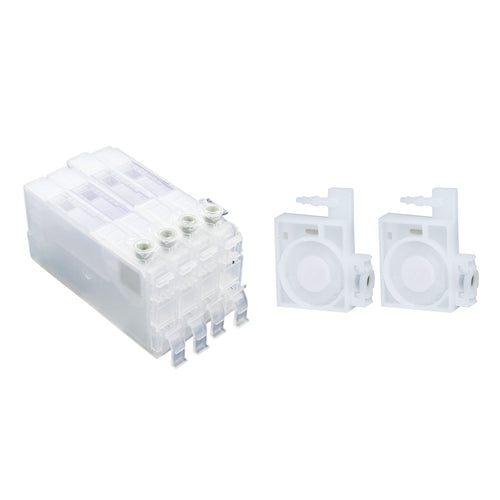When Jason, a small-business owner in Texas, tried printing on nylon gym bags using traditional screen printing, he lost $3,200 in materials due to ink cracking. Switching to DTF technology with premium ink slashed his defect rate to 2% and tripled his profit margins. Stories like Jason’s explain why 78% of apparel decorators now consider DTF essential for competing in today’s market (Source: SGIA 2024 Trend Report). At the heart of this revolution lies dtf ink– the unsung hero determining your print quality, durability, and profitability.
In this article, we’ll explore what DTF printer ink is , its application, and how to select for your needs.
What is DTF Ink?
DTF printer ink is specially formulated for use in DTF printing. It is usually a water-based ink that contains pigments, making it suitable for producing vibrant colors and excellent adhesion to textiles. It utilizes a 5-color CMYKW system (Cyan, Magenta, Yellow, Black, and White) to achieve vibrant, photorealistic prints. The dtf white ink serves as an underbase for dark fabrics or as a highlight layer to enhance the contrast in the image and makes the design pop while the CMYK colors combine to produce a wide color gamut.For even more dynamic results, luminous inks (like neon pink, green, and orange) can be added to create eye-catching designs that glow.

Applications of DTF printer Ink
1. Small, Medium, Large-Scale Apparel Printing
DTF printer ink is a top choice for small to high-volume clothing production due to its speed, durability, and versatility. It's widely used for:
Custom T-shirts, hoodies, and sweatshirts: Print vibrant, detailed designs on cotton, polyester, and blends.

- Sportswear and activewear: Create durable prints on stretchy fabrics like spandex that withstand intense use and washing.

2. Personalized Gift Customization
DTF ink is perfect for creating custom gifts that stand out. It’s ideal for:
- Tote bags: Design practical yet stylish gifts for weddings, birthdays, or corporate events.

Home decor items: Customize pillows, blankets, and wall art with personalized designs.

3. Crafting and Art
For artists and craft enthusiasts, DTF ink is quite fun to play with. It’s used in:
Art prints: Create limited-edition fabric art by printing high-resolution digital paintings or photographs onto canvas or linen.
DIY projects: Print unique patterns for quilting or handmade accessories.
Whether you’re scaling up production or offering bespoke designs, DTF printer ink provide the flexibility and performance to meet diverse demands.
How to Choose the Right DTF Ink
Selecting the right DTF ink is critical for achieving high-quality prints, optimizing costs, and ensuring smooth operations. Below, we break down the key factors to consider: ink performance, price, and after-sales support, and color configuration strategies.
1. DTF Ink Performance
The best dtf ink should meet the following standards:
Color Vibrancy: Look for inks with high pigment density and to ensure prints stay vivid.
Eco-Friendly Formulas: Non-toxic, low-odor inks protect operator health and comply with environmental regulations.
High performance of dtf white ink: The dtf white ink is very important for DTF printers. Large particles or deposits of ink tend to clog the printheads and shorten the life of the DTF printer equipment.
Here, we highly recommend our 🐼Inksonic DTF White Ink with its ultra-fine particle size, it ensures smooth printing without clogging the printhead, while delivering a high density and vivid saturation.
2. Cost and After-Sales Support
While budget-friendly inks may seem appealing, low-quality ink may result in poor printing or equipment failure.Common issues with cheap inks like:
Color Shifts : Prints may appear dull or mismatched due to poor pigment quality.
Clogged Nozzles : Coarse particles or sediment buildup can damage printheads, requiring expensive repairs.
- Poor Wash Fastness : Prints fade or crack after laundering, leading to customer complaints.
Value of After-Sales Support:
- Choose suppliers offering technical support(e.g.,solving problems encountered in the process of use), warranty coverage (e.g., ink defects), and preventive maintenance tips (e.g., cleaning cycles, storage guidelines). Reliable support minimizes downtime and extends equipment lifespan.
3. DTF Color Ink Configuration: Optimize Usage & Avoid Waste
Tailor your ink purchases to your product line to reduce costs and overstocking, for example, if your products have a vintage aesthetic, you’ll likely use more black and white ink, as these colors complement classic and retro designs. By aligning your ink choices with your product style, you can optimize inventory management and reduce waste.
- Example 1: A brand specializing in “dark-themed apparel” (e.g., black hoodies) should allocate 40–50% of its ink budget to black (K) and 20–30% to white (W) for underbase layers.
- Example 2: A babywear brand might prioritize soft pastels:
- White (W): 30–40% (for underbase)
- Cyan (C) & Magenta (M): 15–20% each (to mix gentle pinks, blues, and yellows)
- Black (K): 5–10% (for minimal detailing)
Special Effects(Fluorescent inks):
Fluorescent inks require a dedicated printing channel to achieve their high-visibility effects. If your printer operates on a standard CMYKW system, adding a fluorescent color—like neon pink—will occupy one of these channels. For instance, you may need to replace the white ink channel, which is typically used for underbase layers. You need to strategically plan your ink configuration based on your product line. For example:
Prioritize fluorescent inks for sportswear or high-performance apparel (e.g., neon details on running gear) where bold visibility matters.
Stick to the standard CMYKW setup for everyday clothing to retain flexibility.
DTF Inks FAQs
Q1: How much dtf ink does it take to print one T-shirt?
The amount of ink required depends on the size and complexity of your design. On average:
Small design (e.g., logo): 10–15 ml of ink.
Medium design (e.g., full front print): 15–20 ml of ink.
Large design (e.g., all-over print): 20–30 ml of ink.
Our Inksonic DTF printers equipped with ink usage statistics It can provide real-time monitoring on how much ink is consumed per print job, helping you calculate costs accurately.
Q2: What Are the Highlights of Inksonic DTF Ink ?
Printhead Compatibility:
- Highly compatible with Epson water-based printheads.
- Suitable for Epson desktop printers, A3 DTF printers, and wide-format DTF printers.
High-Quality Raw Materials:
- Formulated with Japanese technology, using German solvents, Japanese resins, and pigments.
- Ensures excellent ink flow and superior color fastness.
Low Ink Consumption:
Utilizes triple refining technology to guarantee low ink usage and stable quality during high-speed printing.
Achieves smooth printing with up to 800 ft per 500ml.
Q3: How do I store DTF inks properly?
Store unopened bottles: In a cool, dark place (10–25°C / 50–77°F).
After opening: Seal tightly and use within 6 months to prevent pigment settling.
Never freeze or expose to direct sunlight!
Conclusion
Choosing the right DTF printer ink is more than just a purchase—it’s an investment in the quality, efficiency, and reputation of your printing business. Ready to elevate your DTF printing game? [Shop Now] to explore our premium ink collection, or [Contact Us] for personalized recommendations. Let’s create something extraordinary together!


































